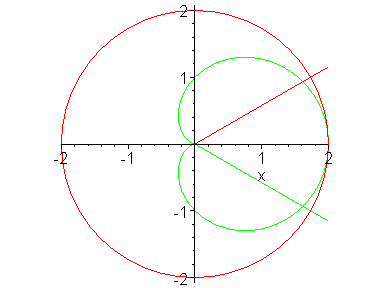Interpretation of dr/d theta
Anytime we create new functions in calculus, we like to consider "the dozen aspects" that mathematicians like to investigate. In this lesson, we have already used the derivative of the polar variables, r and theta, in finding dy/dx, the formula for slope of the tangent line. Now the question arises: "What does dr/d theta mean all by itself?" Below we give a graphical interpretation of the rate of change of radial measurement with respect to the change in the angle.
|
for r>0 |
dr/d theta positive |
as theta increases, r increases, i.e., |
|
|
dr/d theta zero |
as theta increases, r remains constant, i.e., |
| dr/d theta negative | as theta increases, r decreases, i.e., as theta increases, the curve moves closer to the origin |
When r is negative, we get the opposite effect. So we have to be very careful of the sign of the value of r when we interpret dr/d theta.
|
for r<0 |
dr/d theta positive |
as theta increases, r increases from a negative to a
less negative, i.e., |
|
|
dr/d theta zero |
as theta increases, r remains constant, i.e., |
| dr/d theta negative | as theta increases, r decreases to a more negative ,
i.e., as theta increases, the curve moves away from the origin |
Example:
| Consider the cardioid,
r = 1 + cos( theta ), in the plot below. Here, r
>=0 for the entire graph.
The derivative is r' = - sin( theta ) We can see that the graph of the cardioid is: |
|||||||
|
 |
||||||